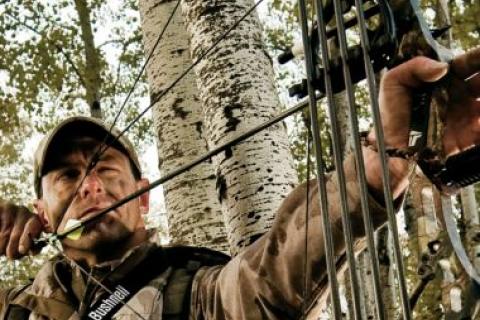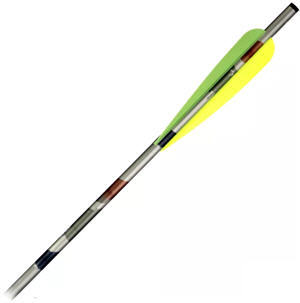
Depending on your bow setup, and whether you compete in 3-D tournaments or just hunt whitetails, finding the arrow that is right for you can be a daunting task. This arrow buyer’s guide will help you understand the differences between the main types of arrows and the fletching that go along with them.
Carbon Arrows Have the Speed Factor

Carbon was first introduced to the bowhunting scene in the form of lightweight, pultruded shafts with an extremely small diameter. These early shafts did produce a lighter arrow, but were prone to splitting upon impact and difficult to tune. In recent years however, carbon shafts have changed considerably, making them an excellent choice for bowhunters and competitive shooters alike.
Today, shafts are either weaved or wrapped, much like a fishing rod, making them stronger and less prone to splitting than earlier versions. One of the main reasons that carbon arrows have taken the archery world by storm is the speed factor. Because these arrows are lighter in weight, archers are able to gain many feet per second by using a carbon arrow.
In addition to being extremely durable, straight, and capable of transferring energy well, carbon shafts have also come down in price in the last couple of years, making them one of the most popular hunting shafts on the market. Shop all carbon arrows at Cabelas.com.

Recurve Bow
Wood Arrows Are Primarily Used by Traditional Bow Shooters

Today the vast majority of wood arrows are predominantly used by recurve and longbow shooters and, in order of age, wood shafts have been around the longest. Traditionally, wood shafts were most commonly made from Port Orford cedar, which is still the most desired material used today. Known for its unique straightness, durability, density, ability to take stain and wonderful smell - Port Orford cedar remains the mainstay of the traditional bowyers art.
Wood shafts are inexpensive, reasonably accurate, heavy enough to penetrate well even the largest big-game animals, and reasonably durable. While wood shafts are good in many regards, they are not perfect. They can bend and take a set; they can also warp when subjected to temperature and/or moisture extremes. In addition to these disadvantages, it should be noted that most wood arrows should not be used with modern, high-velocity compound bows as they can split upon firing – creating a dangerous situation for the archer.
Wood Grain Carbon Arrows
That is why companies like Gold Tip and Beman have created a carbon arrow with a wood finish.
Arrows like the Gold Tip Traditional XT arrow and Beman MFX sport a traditional arrow look, but give you the performance of an advanced carbon arrow.
Aluminum Arrows Are Resistant to Weather & Humidity

While aluminum shafts were introduced as far back as the 1940s, aluminum arrows exploded in popularity as an arrow shaft material in the 1970s and is still the most commonly used material today. Some of its many advantages include inexpensive production, strong constructional integrity, rebounding from minor bending, weather and humidity resistance, and extreme straightness. One thing about aluminum arrows that makes them extremely popular is that year after year, arrow companies find new ways to make them stronger and straighter.
Aluminum - Carbon Hybrid Arrows Generally Have High Kinetic Energy Transference
While not nearly as common as either aluminum or carbon alone, aluminum/carbon hybrids offer a unique arrow shaft design and have become extremely popular among archers in recent years. For their stiffness, they are very lightweight. They also efficiently absorb and transfer energy, and penetrate well due to their relatively small diameter. Aluminum/carbon hybrids are very straight and are reasonably durable - on par with aluminum versions. Aluminum/carbon hybrids are typically constructed using a small-diameter, lightweight aluminum shaft, covered with a wrapped carbon outer layer.
An example of this type of arrow construction would be the Easton ACC. However, with the introduction of the Easton Full Metal Jacket, the construction has been turned inside out, literally. This arrow has carbon on the inside and aluminum on the outside. The main advantage to this type of construction is the easy arrow removal from targets. Their main disadvantage is cost. For hunting arrow material, carbon/aluminum hybrids are one of the most expensive combinations available.

Fletching or Arrow Vanes, the fin-Shaped Aerodynamic Stabilization Device
Plastic arrow vanes are the most common fletching material and have come a long ways in recent years. They are durable, unaffected by moisture, resilient to bending and crumpling, and effectively stabilize a wide range of arrows. Vanes are also available in a plethora of lengths and styles to suit any need from ultrasmall target styles, to high-profile, long, hunting versions. While vanes have many advantages, they are slightly heavier and do not offer as much wind resistance as feathers (which equates to stabilization - sizes and profile being the same), and are less forgiving when obstructions are hit.

From traditional parabolic arrow vanes like those from Bohning Archery, BlackOut DuraVane and Fusion arrow vanes to the modified parabolic versions like those from New Archery Products, choosing a vane specifically fit your needs is easier than ever with recent advancements in technology. And now, a new breed of vane has been put into the mix with the introduction of the Blazer by Bohning Archery. At just 2" long and a mere 5 grains each, these vanes use a combination of super-strong material and precise leading-edge angle to stabilize the large fixed-blade broadheads. They allow you maximize the speed potential of your setup and give you a boost in your extended-range accuracy.
Feather Fletching Gives Greater Arrow Control

While this type of fletch is the oldest, it is still commonly used today and considered a favorite for traditional archers. Archery feathers are faster than vanes during flight and provide the most "drag" or stabilization for an arrow for a given size of fletch.
Tip: Gateway Feathers Right-Wing Archery Feathers offer an authentic quality parabolic die-cut for smooth, natural look and proven arrow control performance.

If you are shooting large surface-area broadheads,you may benefit from better flight characteristics with feathers rather than vanes. Feathers are also more forgiving when an obstruction is hit upon release (such as a rest prong or in the case of a traditional bow, the riser shelf. Feathers will collapse and pass by the obstruction while plastic vanes will throw the arrow slightly off course. Like all things, feathers do have some disadvantages. However, feathers are not as durable, are affected by wet conditions and can be slightly noisier in flight.
There are several different shaft materials that may work for your individual needs. After deciding what type of shaft material you desire and the proper type of fletching to use, simply select the correct shaft for your draw weight and length to find the perfectly balanced arrow for your setup.
Tip: Our Archery Outfitters can help you in selecting balanced arrow setups - find a Cabela's store or Bass Pro Shops store near you here.
- 14784 views

